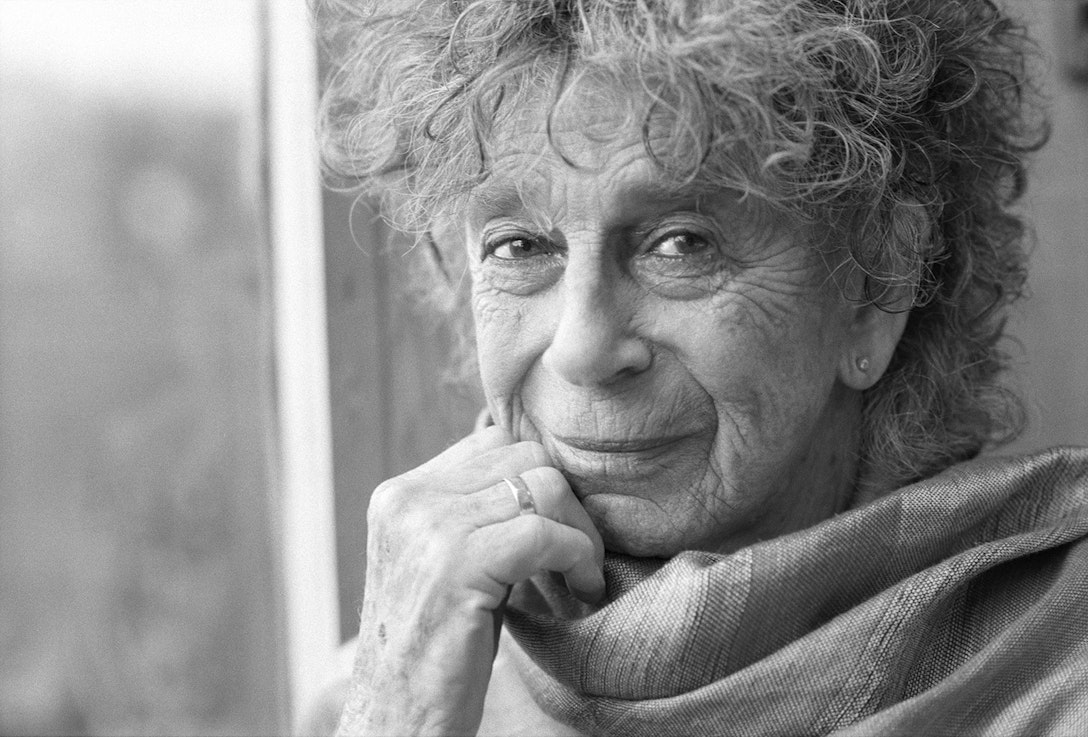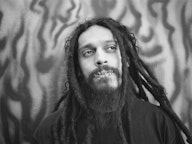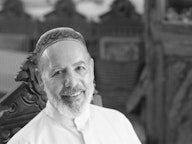
Anna Halprin
Kentfield, California, USA
DANCING WITH GOD
I had cancer. This gave me a ray of hope. It gave me a way to—I wouldn't say exactly ‘fight my cancer,’ but confront it—which is a little different than fighting it. I was put to a test to really confront the issues of life and death because I didn’t know whether I would live or die. And confronting the issues of life and death, for me, was articulating or becoming clear about what my purpose would be if I were to live. What would the purpose of my life be? Why would it make any difference whether I lived or died—to me or to anyone else?
I found a spiritual dimension which came in the form of an animal. It came in the form of a black bird. I was under so much stress and drugs and ether, and I was in a state of near death. I was so weak. I was just totally emptied and I was totally weak. And this black bird came, and I don’t know to this day whether it was one of the crows around here. It came in and sat on my bed. I don’t know to this day whether it really was real. It was a raven, not a crow. And we had a little dialogue. And in the language...of the raven...he did a little circle and sort of flapped its wings and I interpreted his dance as asking me, ‘Well, if you were to live, what is it that you would want to live for?’
And at that moment I experienced a sensation of love. It just kind of swept over me like an ocean; a warm ocean wave. And I said, ‘Oh. Then if I’m going to continue to dance, and go around with dirty feet all the time, and sweat, and struggle to keep creating material that’s useful; I really want to know why I’m doing that.’ And the whole sensation was that ‘I must do this for love.’ I don't think I've ever really experienced love; whatever that was.
It just was a feeling, and it brought me back to my grandfather. It brought me back to, ‘Oh, that’s that same feeling.’ Whatever it was...it was that same feeling I had when I was a little girl. And that has pretty much defined my work. It has pretty much defined the choices I make where I’m going to place my energies, and what kind of dances I’m going to do, and who I’m going to do them for, and why I’m doing them, and, why I’m even teaching. And it has been a definition for me in my life in terms of making choices and giving me a direction and a path to follow. And I don’t know if this is faith, but it's something different than my ordinary life; something that has a slightly different consciousness to it. But I always come back to it. I always come back to it.
Daniel’s Reflection
Anna Halprin is considered the mother of post- modern dance. In the 1930s and 1940s she was a modern dancer in New York, participating in the style of dancers such as Martha Graham. But she became a breaker of the rules of modern dance by bringing it off the stage—into the audience, and into nature. Anna elevated improvisational movement and created a deeper, more spiritual and healing approach to dance.
Anna and her famous architect husband, Lawrence Halprin, set up home in Marin County north of San Francisco. He built her a dance deck that expanded into the forest outside their home. There she taught generations of dancers to integrate with nature and the realities of life.
I met Anna Halprin when I went to her annual week-long movement workshop at Esalen, the human potential retreat center in Big Sur. At the time, Anna was 87 years old. I interviewed her and made her portrait two years later.
Anna’s earliest inspiration was her Hasidic grandfather who she would meet at synagogue every Shabbat on Chicago’s west side where she grew up. She would watch him lovingly from the women’s balcony and see him pray and dance with ecstasy. Her child-like understanding was that her grandfather must be God and this is how God must pray! Anna says she has been trying to find a dance that means as much to her as her grandfather’s dance meant to him. It opened the door to a mystical understanding of dance and movement.
Anna is known for her interdisciplinary approach to dance. One such method that I got to experience personally in her workshop is where the participant draws a self-portrait and then creates movement to express the portrait. Once, when Anna was in her 50s, she did this exercise, but for some reason she drew a mass in her pelvis. Concerned, she got checked by a doctor and a tumor was discovered. Anna was diagnosed with colorectal cancer. She was then faced with a painful treatment journey that changed her life and her work in dance.
A pivotal moment came for Anna when she had a mystical experience with a raven. To this day, she is not certain if it was a dream or real. She understood the raven to ask her if she were to live, what would she live for? A warm rush of love came over Anna and she had her answer. She would live for love. She would dance for love.
I’d seen Anna quoted on a website related to her film, “Breath Made Visible,” as saying: “Before I had cancer, I lived my life for my art. After I had cancer, I lived my art for my life.” I certainly felt that love during my time with Anna, both in the workshop, and at her home while interviewing her. That same love led Anna to be an innovator in using dance to heal racial conflict during the civil rights movement, to work with HIV+ and AIDS patients, to work with elderly and the dying, and with Alzheimer’s patients. I heard her say a profound thing—that a cure is sometimes and sometimes not available. But healing is always available.
One of the most dramatic events in Anna’s life was a time when the mountain she lives next to, Tamalpais, closed to the public after seven women were murdered there. The “trailside killer” had kept the community from using the mountain and people wanted to reclaim “Mount Tam” as their own. Anna worked with the community and she created a series of dances and rituals performed on the mountain on a day chosen by the community. The focal point of the day was “The Planetary Dance,” a simple but intricate series of concentric circles moving in opposite directions. A single drummer was at the center. Each participant started off by declaring their intention for the dance.
This choreography is a very powerful experience. I took part in a “Planetary Dance” at the Esalen workshop. In the case of the original dance, the killer was found one week later. I love how Anna understands those events—that it was not necessarily something mystical; it was the community coming together itself to reclaim the mountain, to bind together, to expel the killer. This is, in itself, an act of faith.
“The Planetary Dance” has now been performed around the world for 40 years, each time with a different goal or focus. When I interviewed Anna, her concern was for the safety of Barack Obama during his presidency.
This idea that dance and movement are deeply authentic forms of spirituality was new to me. I am grateful to have found the research and writings of Eline Kieft, Ph.D., a professor in the United Kingdom with specialization in dance anthropology and movement medicine. Dr. Kieft wrote a very helpful paper: “Dance as a Moving Spirituality: A Case Study of Movement Medicine.” Here she explains experiencing spirituality through motion:
“In many cultures and spiritual traditions, dancing is practiced as a means of coming closer to spirit, to encounter the divine, and as an expression of that relationship that already exists. Dancing can be still, quiet, receptive and reflective, as well as exuberant and celebratory. It includes all aspects of the body-heart-mind unity or continuum, each of which finely influence and affect each other.”
Dr. Kieft offers in her paper four ways in which “danced spirituality” is different from other forms of spirituality:
“Firstly, danced spirituality is fundamentally different from other forms of spirituality because it is embodied nature-in-movement, as opposed to stationary and still spiritual practices in which either the body is not considered as significant for reaching and attaining communication with spirit, or where a specific posture is adopted and maintained for the duration of a prayer or meditation.
“Secondly, dancing offers another way of knowing other than exclusively through the rational mind. Because of their very nature, spiritual dimensions are not rationally knowable, but have to be perceived with other faculties, senses or modes of perception.
“Thirdly, all our experiences are intersubjective, and are shaped by the reciprocal relationship between the interior of the body and exterior of the outer world, which mutually influence and contain each other (see also Fleckenstein, 1999: 287; Shusterman, 2000: 159). The dialogue between the person, context and environment becomes very tangible on the dance floor, including personal, social, environmental and cosmological dimensions.
“Finally, dance as a spiritual practice emphasizes the practitioner as an actor and a creator. Being in touch with life forces and vitality generates strength to manifest insights into action. On the dance floor, meaning and understanding emerge. Various possibilities of behaviour for everyday life can be explored, rehearsed and embodied, which is the first step for developing and realizing them (see also Buckland, 2002: 122-3; D. Halprin, 2003: 19).”
Anna Halprin so profoundly changed my understanding of how to access faith and spirit. I’ve been deeply moved by her stamina across generations of teaching and raising issues that needed to be addressed in society.
Anna died at the age of 100, just as the Portraits in Faith coffee table book was going to press. Her daughter, Dara Halprin, informed me that because of dementia Anna lost the ability to talk, walk, or get out of bed. It is impossible for me to imagine Anna unable to communicate or move. It reminds me of the great cycle of life and our mortality and the urgency with which we must do our work. I thank Anna for decades of helping people like me reconnect with my inner essence, to reconnect with nature's goodness, harshness, and the beauty of reality.
I asked Anna what she thought happens after death: “I'm not very mystical about that. I just feel that when you die, what you leave behind are your deeds; whatever you've done that has touched somebody else that is useful in their life or has touched them in some way. I think it's just like nature. Your energy has just changed, like a tree. It's planted, it grows, reaches maturity, and at a certain point it falls over, dies, and it goes back to the earth. So, it just recycles. I suppose that when you die, your body will just change its energetic forces. I mean, the energy is always going to be there, but it will just be in another form. It's like, when I eat a carrot, I'm eating the sun, ’cause it took the sun, you know, to grow the carrot. It's just constant recycling of your energetic forces. But I don't have any, you know, mystical ideas [about what happens] after death.”
Thank you to Anna Halprin for her life’s work and teaching us all with great love.
Permissions and References
-
Kieft, E. “Dance as a moving spirituality: A case study of Movement Medicine.” Dance, Movement & Spiritualities, volume 1 (1): 21-4, (2013).
Permission to quote text from this dissertation was given to the author by May Yao of Intellect Publishing on November 11, 2020.
Explore the portraits by theme
- happiness
- grief
- addiction
- sexuality
- sobriety
- transgender
- alcoholism
- suicide
- homelessness
- death
- aggression
- cancer
- health
- discipline
- abortion
- homosexuality
- recovery
- connection
- enlightenment
- indigenous
- depression
- meditation
- therapy
- anger
- forgiveness
- Doubt
- interfaith
- worship
- salvation
- healing
- luminaries

